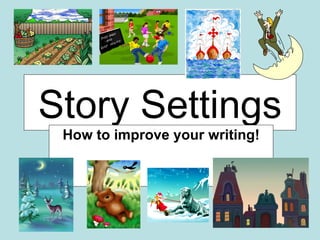
Setting The Scene
- 1. Story Settings How to improve your writing!
- 2. You can start your story by thinking about the setting. Where does your story take place? What time of What is the Is it inside day is it? weather like? Or outside?
- 3. Manipulate the reader with the setting. Use place as well as the weather, time of day and season, to create a setting. After all, a walk along a lane on a summery afternoon creates one atmosphere but the same lane on a dark wintry night would feel very different.
- 4. Use detail to bring the setting alive - base this on sense impressions. • What can be seen, heard, smelt, touched and tasted? • If the reader is to enter your world, s/he needs to be able to • see it • hear it • touch it • taste it • smell it
- 5. Base settings on places that you know - plus some invented detail. • Think of places where • Do you want details to you have been. make your setting • Close your eyes and seem: look at all the details • dangerous? around you. What • frightening? can you see? • fun? • Now use your • safe? imagination to change the place. Add some • peaceful? interesting details. • strange/imaginary?
- 6. Use the setting to create atmosphere • For instance, you might use a frightening place such as an empty house - or you can take a very ordinary place and make it seem scary by making it seem unusual, dark and cold.
- 7. Remember: • Do not get bogged down in too much description or you will lose the pace of the narrative.
- 8. Use real or invented names to bring places alive • Names help to make your setting more real and more believable. • ‘A boy walked down a street’ shows us nothing, but ‘Lugs O’Neill limped down Butcher’s Row’ starts to catch our imagination.
- 9. Once you have built the setting you can bring in the characters. Who is there and why? Have fun creating your story setting!